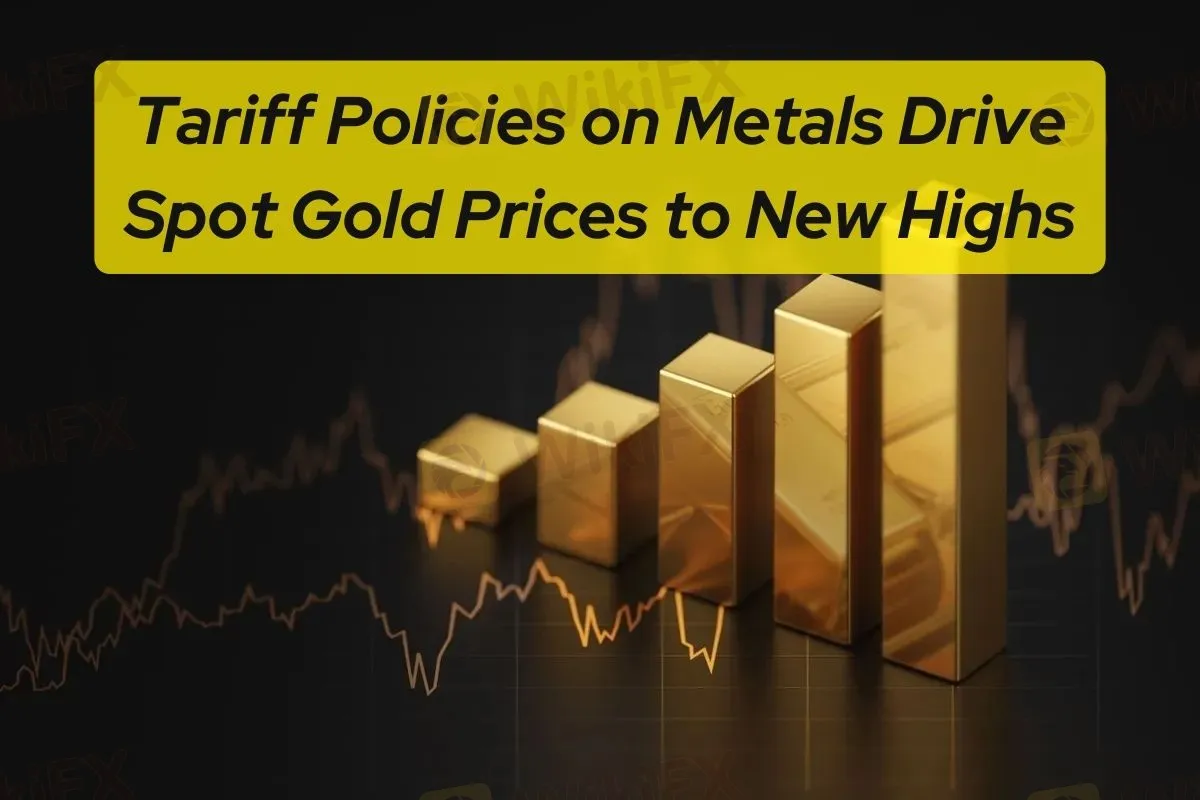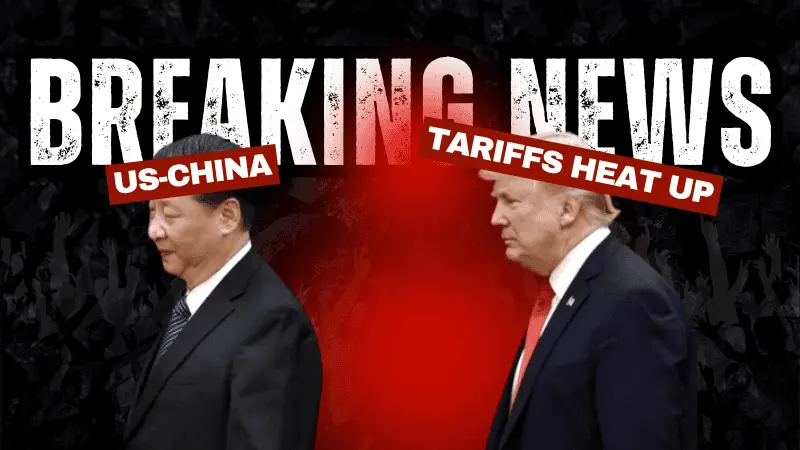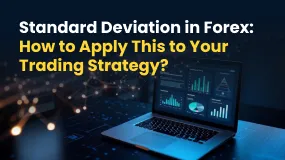简体中文
繁體中文
English
Pусский
日本語
ภาษาไทย
Tiếng Việt
Bahasa Indonesia
Español
हिन्दी
Filippiiniläinen
Français
Deutsch
Português
Türkçe
한국어
العربية
Tariff Policies on Metals Drive Spot Gold Prices to New Highs
Abstract:Gold hits a record $2,926 as Trump’s metal tariffs, inflation fears, and geopolitical risks drive investor demand for safe-haven assets.

Gold prices have surged to $2,926 per ounce, setting a new all-time high as investors react to a confluence of economic uncertainties, inflationary pressures, and shifting global trade policies. The rally has been further fueled by market volatility, central bank actions, and the expansion of tariffs on metals by the Trump administration.
Rising geopolitical risks and concerns over a slowing global economy have also played a role in golds surge. Many institutional investors and central banks are increasing their gold holdings, reinforcing its status as a safe-haven asset amid economic turbulence.
Trumps 25% Metal Tariffs and Their Market Impact
US President Donald Trump recently signed an executive order expanding tariffs on steel and aluminum, applying a 25% duty on all imports of these metals, effectively canceling trade agreements with the European Union, the United Kingdom, Japan, and other key allies.
The new executive order builds upon the 25% steel and 10% aluminum tariffs imposed during Trumps first administration in 2018, but it removes previous exemptions, closes loopholes, and raises tariffs on downstream products beyond raw materials. The White House also hinted at further tariff measures on automobiles, semiconductors, and pharmaceuticals.
Market Reaction to Tariff Expansion
Following the announcement, the US dollar strengthened, attracting some buyers. At the time of writing, the DXY index rose by 0.05% to 108.37, reflecting a shift in investor sentiment towards the US currency as protectionist policies were enacted.
At the same time, the gold market responded positively, as increased tariffs heightened concerns about inflation, supply chain disruptions, and potential retaliatory measures from trade partners. Investors sought refuge in gold, leading to another spike in prices.
Other Key Drivers of the Gold Rally
- Federal Reserve Policy and Potential Rate Cuts:The Federal Reserve is expected to cut interest rates in 2025, which could weaken the dollar further and provide additional momentum for gold prices.
- Geopolitical Instability and Global Economic Concerns:Trade disputes, military conflicts, and economic sanctions have heightened global uncertainty, prompting investors to seek safe-haven assets.
- Central Banks and Institutional Demand:Several central banks, including China, Russia, and India, have increased gold purchases, reinforcing its role as a reserve asset.
Market Reactions from Experts and Institutions
Giovanni Staunovo, an analyst at UBS, stated, “We expect gold prices to receive further support and rise to $3,000 per ounce.” His outlook is based on continued demand from central banks, geopolitical uncertainties, and the expanding trade conflict, which are all factors that could drive gold higher.
Daniel Hynes, senior commodity strategist at ANZ, noted, “Gold could become entangled in retaliatory tariffs, which is already creating disruption in the physical market.” He emphasized that protectionist measures and ongoing trade disputes could impact supply chains, leading to increased demand for gold as a hedge against economic uncertainty.
Kelvin Wong, senior market analyst for Asia-Pacific at OANDA, expressed confidence in gold‘s upward momentum, stating, “I don’t see much possibility for a pullback at the moment unless we start seeing a strong rally in the U.S. dollar.”His view suggests that as long as the dollar remains stable or weak, gold will continue to find support from investors seeking safe-haven assets.
These expert assessments reinforce the notion that golds rally is far from over, with many analysts expecting sustained strength amid shifting global trade policies and market volatility.
Disclaimer:
The views in this article only represent the author's personal views, and do not constitute investment advice on this platform. This platform does not guarantee the accuracy, completeness and timeliness of the information in the article, and will not be liable for any loss caused by the use of or reliance on the information in the article.
Read more

Top Tips to Avoid Forex Margin Calls and Protect Your Capital
While technical indicators or chart patterns often capture the attention of forex traders, especially new ones, aspects such as margin requirements, equity, used margin, free margin, and margin levels are often overlooked. So, if you have received a margin call from your forex broker and are wondering how to deal with it, you probably do not know the concept of a forex margin call - what triggers it and how to avoid it. Being unaware of this concept can make you lose your hard-earned capital. In this article, we will provide you with all the information you need to know. Keep reading!

US-China Tariffs Heat Up—Pause Still Possible, Says Bessent
President Trump signaled the U.S. and China are effectively in a trade war, even as Treasury Secretary Scott Bessent left room to extend a current tariff pause and a Trump–Xi meeting remains on the calendar. After floating a new 100% tariff on Chinese goods from Nov. 1, tensions seesawed amid Chinese sanctions and U.S. threats over soybeans. Some U.S. tariffs (up to ~145%) are paused until Nov. 10, with a Supreme Court test of “reciprocal” tariffs looming. Companies are adapting unevenly—Stellantis expanding in the U.S., while Apple deepens ties in China—suggesting continued market volatility.

Crypto, Euro, Yuan: Still No Dollar Killer
Despite frequent “de-dollarization” headlines, the U.S. dollar remains unrivaled due to unmatched market depth, global usability, and trusted legal/institutional frameworks. Crypto and other currencies (euro, yuan) lack the stability, convertibility, and infrastructure required to replace the USD, while the Fed’s credibility and the scale of U.S. financial markets continue to anchor demand. Bottom line: no alternative currently offers a complete, credible substitute for the dollar’s global role.

Standard Deviation in Forex: How to Apply This to Your Trading Strategy?
Do you recall the concept of standard deviation being taught in your school days? The concept, which measures the variation within a set of data points relative to the mean average of the dataset. A greater standard deviation hints at higher variability. On the other hand, a lower standard deviation means lower variability from the mean. But what is standard deviation in forex, and how can you apply it to your trading strategy? This is what we will discuss here.
WikiFX Broker
Latest News
Consob Targets Political Deepfake “Clone Sites” and Unlicensed Platforms in Latest Enforcement Round
WikiEXPO Global Expert Interviews: Gustavo Antonio Montero: ESG in Finance
2 Malaysians Arrested in $1 Million Gold Scam Impersonating Singapore Officials
Is FXPesa Regulated? Real User Reviews & Regulation Check
Fraud Mastermind Zhimin Qian Sentenced to 11 Years for $6.6 Billion Bitcoin Ponzi Scheme
Almahfaza Broker – 2025 Review: Safe or Scam?
Uniglobe Markets Review 2025: A Complete Guide to an Unregulated Broker
INZO Broker No Deposit Bonus: A 2025 Deep Dive into Its Offers and Risks
Exness Broker Expands in South Africa with Cape Town Hub
Global Guide to Finding Forex IBs/Brokers — Share Your Pick and Win Big!
Currency Calculator



